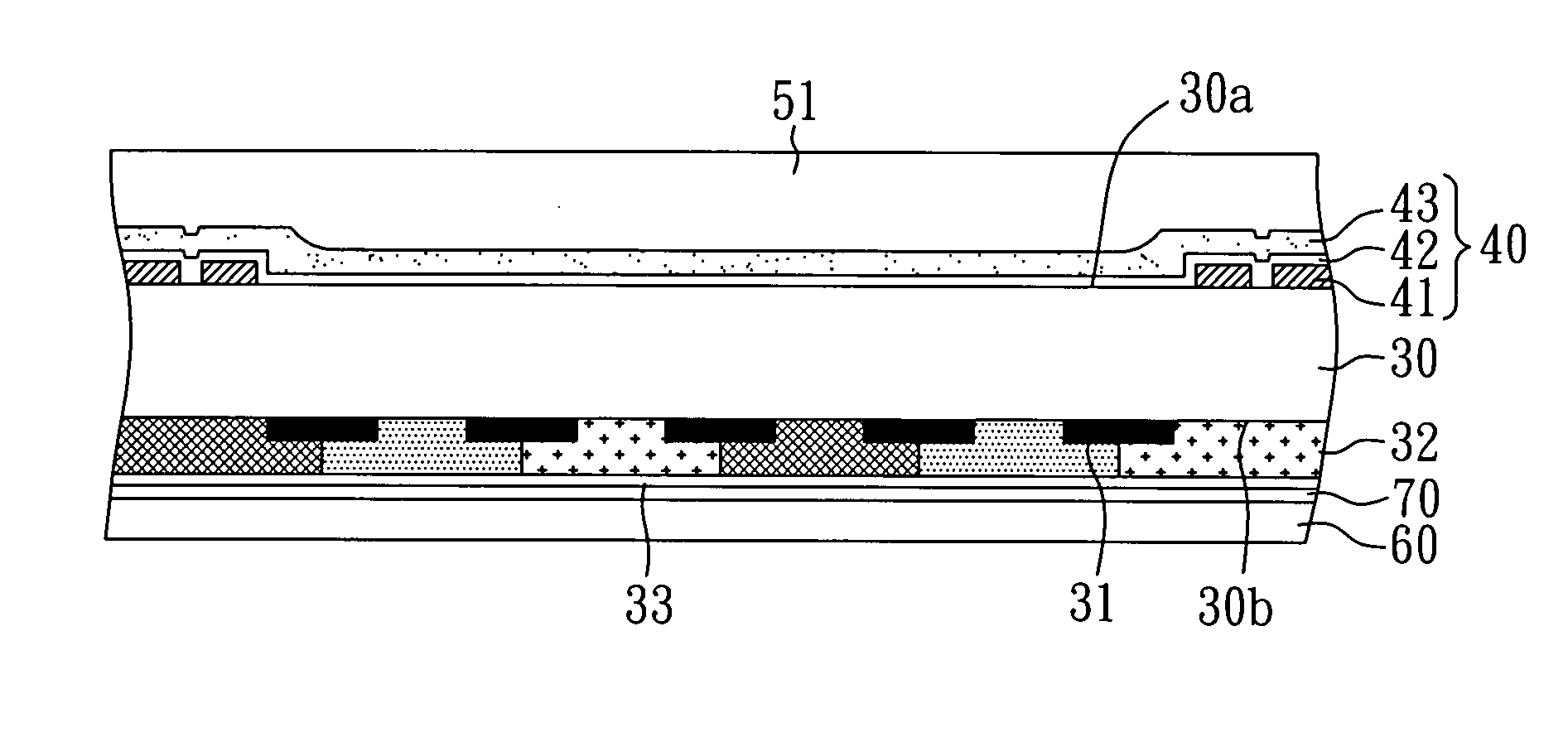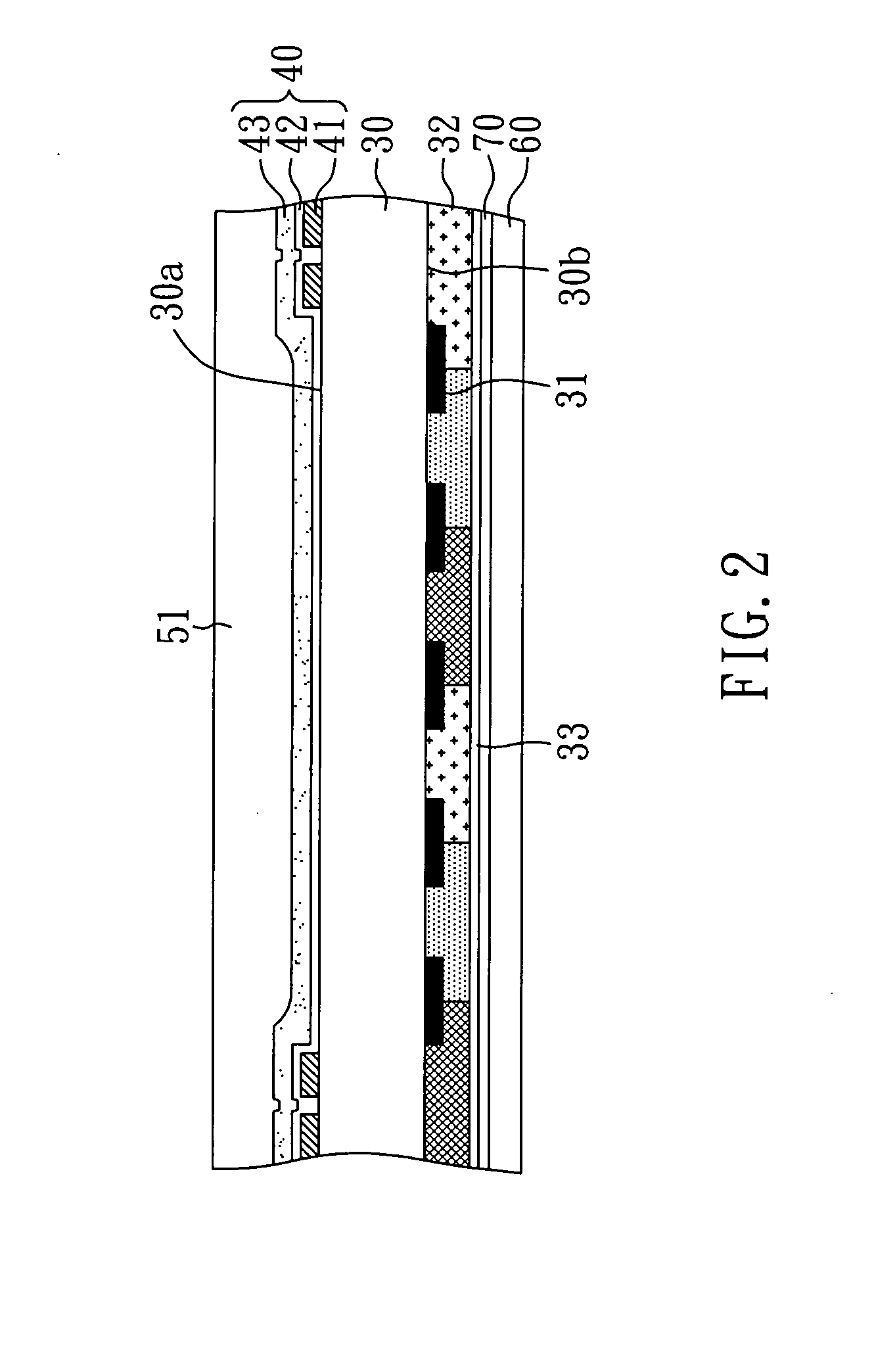Touch-sensing display device and method for manufacturing the same
a display device and touch sensor technology, applied in semiconductor devices, instruments, computing, etc., can solve the problems of reducing transmittance, difficult to produce a light and slim touch panel display device, and too much weight and total thickness of the device, and achieve the effect of high transparency and low cos
- Summary
- Abstract
- Description
- Claims
- Application Information
AI Technical Summary
Benefits of technology
Problems solved by technology
Method used
Image
Examples
example 1
[0045]Referring to both FIGS. 2 and 3, wherein a schematic view of a display device and a process flow chart of the first substrate are shown respectively, the method of providing a display device of the present example is described below.
[0046]First, a first substrate 30 having a first surface 30a and a second surface 30b is provided. Herein, the first substrate 30 can be a glass substrate.
[0047]Then, a touch-sensing element 40 is formed on the first surface 30a of the first substrate 30, wherein the steps of forming the touch-sensing element 40 comprise: forming a patterned electrode 41 on the first surface 30a of the first substrate 30, in which the electrode layer 41 may be made of molybdenum / aluminum (Mo / Al) (Al formed before the formation of Mo) or Mo / Al / Mo (Mo formed first, following with Al, and then Mo formed at last). Herein, the patterned electrode 41 locates correspondingly on the periphery of the first substrate 30, as shown in FIG. 4. However, the tracing line and the ...
example 2
[0051]This is the same method as in Example 1, except that a polarizing material or a polarizing element, which is able to polarize lights, is directly used to replace the silicon nitride (SiNx) to form the passivation layer 431 on the conductive layer 42 and on the patterned electrode 41 of the present example (as shown in FIG. 6). Thereby, the passivation layer 431 of the present example is able to possess the polarizing function (the same as that of the polarizing element 51, as shown in FIG. 2) and passivation function at the same time. Hence, there is no excess need of attaching the polarizing element 51 (as shown in FIG. 2). Other steps are the same as those of Example 1 to produce a display device.
example 3
[0052]With reference to FIGS. 7 and 8, the method of fabricating a display device here is the same as that of Example 1, except that the conductive layer 42 is firstly formed on the first surface 30a of the first substrate 30, then the formation of the patterned electrode 41 electrically connected to the conductive layer 42 follows when producing the touch-sensing element 40. The electrode layer 41 may be made of Al / Mo (Al formed after the formation of Mo) or Mo / Al / Mo (Mo formed first, following with Al, and then Mo formed at last). The patterned electrode 41 locates correspondingly on the periphery of the first substrate 30, and the layout of the patterned electrode 41 may be the same as that in Example 1. Other steps are the same as those of Example 1 to produce a display device.
PUM
 Login to View More
Login to View More Abstract
Description
Claims
Application Information
 Login to View More
Login to View More - R&D
- Intellectual Property
- Life Sciences
- Materials
- Tech Scout
- Unparalleled Data Quality
- Higher Quality Content
- 60% Fewer Hallucinations
Browse by: Latest US Patents, China's latest patents, Technical Efficacy Thesaurus, Application Domain, Technology Topic, Popular Technical Reports.
© 2025 PatSnap. All rights reserved.Legal|Privacy policy|Modern Slavery Act Transparency Statement|Sitemap|About US| Contact US: help@patsnap.com



